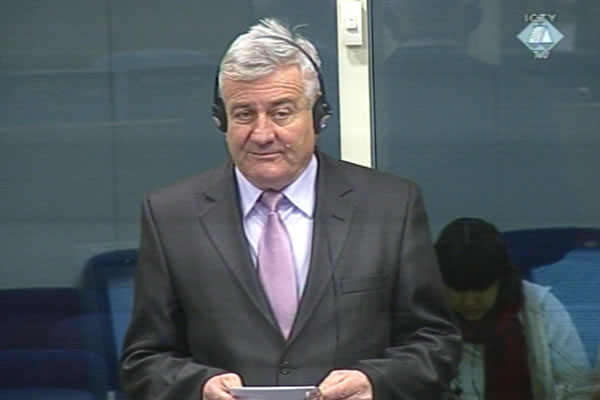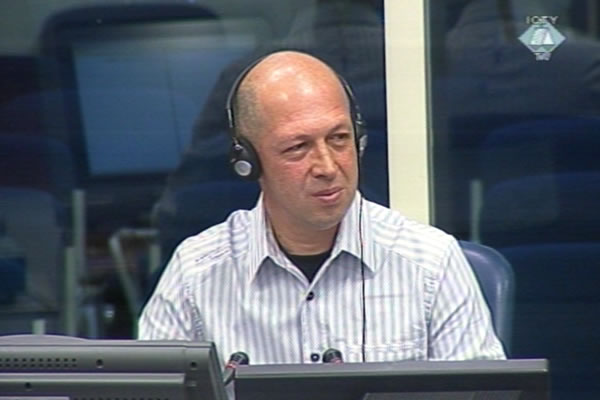Home
SEE NO EVIL, HEAR NO EVIL
Karadzic’s defense witnesses deny that the Serb troops were responsible for incidents listed in the indictment: the shelling of a water queue in Dobrinja and the attack with a modified air bomb on the University Hospital in Dositejeva Street in Sarajevo. The first witness claimed that the Serb side couldn’t see the street in Dobrinja. The other witness, despite saying he didn’t know where Dositejeva Street was, ‘assumed’ that the VRS didn’t launch the air bomb. According to the witness, he didn’t hear it and ‘it was not likely I would miss such a noise’
 Mile Sladoje, defence witness of Radovan Karadzic
Mile Sladoje, defence witness of Radovan Karadzic Radovan Karadzic’s trial continued with the evidence of former VRS soldiers Mile Sladoje and Zoran Kovacevic, who testified about the operations of Serb forces around Sarajevo.
Sladoje started out as the commander of the military barracks in Nedzarici and later became the deputy commander of one of the battalions in the Ilidza Brigade. According to the summary of the witness’s written statement, there were no professional officers or trained snipers in his unit. The BH Army 101st and 102nd Brigades were deployed in high-rise buildings and their combat positions were located in civilian zones, and were in a better position than the witness’s battalion. The witness claims that there were no fully civilian housing estates in Sarajevo. This is why civilian casualties were possible when Serbs returned fire, the witness contends, but it was just ‘collateral damage’. The BH Army was responsible for the casualties because its troops were located in close proximity to residential areas or even in residential buildings.
Sladoje denied that the Serb side was responsible for some of the incidents listed in the indictment. Prosecutor Carolyn Edgerton was prompted to ask the witness why he used the word ‘purported’ to describe the massacre of civilians in the water queue in Dobrinja on 12 July 1993. The witness ‘suspects’ it was all ‘staged’. He found it ‘suspicious’ that the Muslims ‘had gathered the people to play ball’ during a ceasefire and then incidents would happen. To prove that the Serb side wasn’t responsible for the massacre in Dobrinja, the witness claimed that the street in which the citizens of Sarajevo queued for water couldn’t be seen from his positions. Even if they had wanted to open fire, they wouldn’t have known when to do so, the witness argued.
Zoran Kovacevic was the last defense witness today. Kovacevic was drafted and became a private in the infantry brigade in Vogosca; his brigade guarded the explosives depot in the Pretis factory. In late 1994, the witness was promoted and became the commander of a mixed artillery battalion. In his statement, the witness said that his unit fired at Mount Zuc. They strove to avoid civilian casualties and didn’t return fire if they thought that civilians could be hurt. The witness contends that a modified air bomb was not launched from the Pretis factory or from his brigade on 16 July 1995 targeting Dositejeva Street. As alleged in the indictment, the oncology department of the University Medical Center was hit and several persons were wounded.
In the cross-examination, the witness said he didn’t know where Dositejeva Street was. The prosecutor asked the witness how he could claim then that the street had not been attacked. The witness replied that he ‘assumed’ that launching such a bomb was very noisy and people would have heard it. Kovacevic was then shown VRS documents in which his superior requested the delivery of air bombs. In his reply, the witness once again contradicted himself. ‘I don’t claim there were no air bombs but I can’t say either yes or no’, the witness said.
Photos
Linked Reports
- Case : Karadzic
- 2012-11-27 STATUS OF PARAMILITARY TROOPS IN THE VRS
- 2012-11-15 KARADZIC’S ‘SARAJEVO GAMBIT’
- 2012-11-14 SARAJEVO SIEGE UPSIDE DOWN
- 2012-11-29 KARADZIC MANAGES TO SNEAK IN EVIDENCE ABOUT CRIMES COMMITTED BY THE BH ARMY
- 2012-11-30 ILIDZA BRIGADE AND ‘200 M STANDARD’
- 2012-12-04 VIEW FROM METALKA BUILDING

